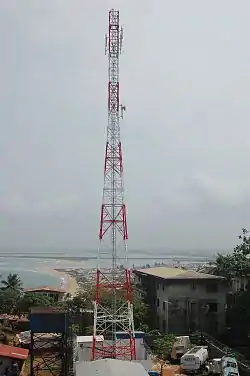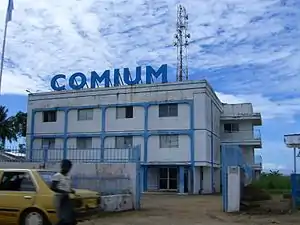Mass media in Liberia
Mass media in Liberia include the press, radio, television, fixed and mobile telephones, and the Internet.

Much of Liberia's communications infrastructure was destroyed or plundered during the two civil wars (1989-1996 and 1999-2003).[1] With low rates of adult literacy and high poverty rates, television and newspaper use is limited, leaving radio as the predominant means of communicating with the public.[2]
Even as it struggles with economic and political constraints, Liberia's media environment is expanding. The number of registered newspapers and radio stations (many of them community stations) is on the rise despite limited market potential. And politically critical content and investigative pieces do get published or broadcast.[3]
Press
The main newspapers are:[4]
- The Analyst[5][6]
- Pumah Times Newspaper
- Daily Observer (est. 1981), private.[5][7][6]
- The Daily Talk[8]
- FrontPage Africa, private.[7]
- The Inquirer, private daily.[7]
- National Chronicle[9]
- The New Dawn, private daily.[7]
- New Democrat[5]
- The New Republic[10]
Defunct newspapers and magazines include:[11]
- Africa League
- African Nationalist[12]
- Africa's Luminary (est. 1839)
- Amulet (est. 1839)
- Daily Listener (est. 1950)
- Footprints Today (est. 1984)
- The Friend
- Independent Weekly
- Journal of Commerce and Industry
- Liberia and West Africa (ceased in 1932)
- Liberia Herald (est. 1826)[13]
- Liberian Age (est. 1946)
- Liberian Herald
- Liberian News[12]
- Liberian Recorder (est. 1897)
- Liberian Star (est. 1839)
- Monrovia Observer (est. 1878)
- Palm Magazine
- SunTimes
- Weekly Mirror[12]
- Whirlwind[12]
Radio
- Radios: 790,000 radio receivers (1997).
- Radio stations: 1 state-owned radio station, but no national public service broadcaster;[14] about 15 independent radio stations broadcasting in Monrovia, with another 25 local stations operating in other areas; transmissions of 2 international broadcasters are available (2007).[15]
- BBC World Service 103 FM.[7]
- ELBC FM, public.[16]
- ELWA FM and SW, private, religious-Christian.[7]
- Pumah FM 106.3
- LUX 106.6 FM, University of Liberia.
- Radio Liberia FM, operated by the state-run Liberian Broadcasting System (LBS).[7][6]
- Radio Veritas FM and SW, religious-Catholic.[9]
- RFI English FM, the English service of Radio France Internationale.[16]
- Sky FM[7]
- STAR Radio FM and SW, operated in partnership with Swiss-based Hirondelle Foundation.[5][7][17]
- Truth FM[5]
- UNMIL Radio FM, operated by the United Nations mission.[7]
- Voice of Firestone Liberia 89.5 FM[18]
Television
- Television sets: 70,000 sets (1997).
- Pumah TV Channel 4
- Television stations: 4 private TV stations, none with national reach;[7] satellite TV service available (2007).[15]
- Liberia Broadcasting System: Government owned Liberia National Television (LNTV).
Telephones

- Calling code: +231
- International call prefix: 00[19]
- Main lines: 3,200 lines in use, 213th in the world (2011).[15]
- Mobile cellular: 2.4 million lines, 138th in the world (2012).[15]
- Telephone system: the limited services available are found almost exclusively in the capital Monrovia; fixed-line service stagnant and extremely limited; telephone coverage extended to a number of other towns and rural areas by four mobile-cellular network operators; mobile-cellular subscription base growing and teledensity reached 50 per 100 persons (2011).[15]
- Satellite earth stations: 1 Intelsat (Atlantic Ocean) (2010).[15]
- Communications cables: Africa Coast to Europe (ACE) cable system, links countries along the west coast of Africa to each other and on to Portugal and France.[20]
The fixed line infrastructure of Liberia was nearly completely destroyed during the civil wars (1989-1996 and 1999-2003).[1]
Prior to the passage of the Telecommunications Act of 2007, the state-owned Liberia Telecommunications Corporation (LIBTELCO) held a legal monopoly for all fixed line services in Liberia, and remains the sole licensed fixed line telephone service provider in the country.[21]
Four licensed GSM cellular mobile service providers operate in the country: Lonestar Cell, CellCom, LiberCell, and Comium. Approximately 45% of the population has cell phone service.[1]
Internet
- Top-level domain: .lr[15]
- Internet users:
- Fixed broadband: 78 subscriptions, 193rd in the world; less than 0.05% of the population, 192nd in the world (2012).[22][24]
- Wireless broadband: Unknown (2012).[25]
- Internet hosts: 7 hosts, 228th in the world (2012).[15]
- IPv4: 13,312 addresses allocated, less than 0.05% of the world total, 3.4 addresses per 1000 people (2012).[26][27]
Notable commercial websites
While Liberia's commercial internet sector is still behind the majority of African countries there are still a few classifieds sites:
Internet censorship and surveillance
There are no government restrictions on access to the Internet or reports that the government monitors e-mail or Internet chat rooms.[28]
The constitution provides for freedom of speech and press, and the government generally respects these rights in practice. Libel and national security laws place some limits on freedom of speech. Individuals can generally criticize the government publicly or privately without reprisal. Some journalists practice self-censorship. The constitution prohibits arbitrary interference with privacy, family, home, or correspondence, and the government generally respects these prohibitions in practice.[28]
President Sirleaf endorsed and signed the World Association of Newspapers and News Publishers' Declaration of Table Mountain in Monrovia on 21 July 2012, committing to the core principles of a free press and calling for the repeal of the criminal defamation and insult laws regularly used against journalists.[28]
See also
- Liberia Telecommunications Corporation, the sole provider of fixed line telephone services in Liberia.
- Cable Consortium of Liberia, a public-private partnership formed in 2010 to own and operate Liberia's cable landing point for the ACE cable system.
- The Liberian Journal, a US-based Liberian online and print news organization covering issues of interest to Liberians in the Diaspora.
- Cinema of Liberia
References
 This article incorporates public domain material from the CIA World Factbook document: "2014 edition".
This article incorporates public domain material from the CIA World Factbook document: "2014 edition". This article incorporates public domain material from websites or documents of the United States Department of State.
This article incorporates public domain material from websites or documents of the United States Department of State.
- "PPIAF Supports Telecommunications Reform and Liberalization in Liberia" (PDF). Public-Private Infrastructure Facility (PPIAF). July 2011. Retrieved 3 September 2011.
- "Introduction to Communication and Development in Liberia" Archived 2014-03-07 at the Wayback Machine, AudienceScapes. Retrieved 8 February 2014.
- "Media Environment and Regulation in Liberia" Archived 2016-03-04 at the Wayback Machine, AudienceScapes. Retrieved 8 February 2014.
- "Liberia Newspapers and News on the Internet", Africa South of the Sahara, Stanford University Libraries. Retrieved 8 February 2014.
- "Liberia: LMC Extols Media Institutions", The NEWS, 16 September 2008, AllAfrica. (subscription required)
- "Liberia: Media and Publishing". Encyclopædia Britannica. Retrieved 21 August 2017.
- "Liberia profile", BBC News, 14 March 2012.
- Lydia Polgreen (4 August 2006). "All the News That Fits: Liberia's Blackboard Headlines". The New York Times.
- "Media regulator recommends support for local media coverage of truth commission", BBC Monitoring Africa, 27 June 2008.
- "Liberia: Ties With China Can't Be Understated", The NEWS, 16 September 2008, AllAfrica. (subscription required)
- Falola 2015.
- Newspaper & Current Periodical Room. "Liberia". 19th and 20th Century Foreign Newspapers in Original Format: Inventory. Washington DC: U.S. Library of Congress. Retrieved 22 August 2017.
- D. Elwood Dunn; et al. (2001). Historical Dictionary of Liberia (2nd ed.). Scarecrow Press. ISBN 978-1-4616-5931-0.
- "Most Used Media Outlets in Liberia" Archived 2014-02-21 at the Wayback Machine, AudienceScapes. Retrieved 8 February 2014.
- "Communications: Liberia", World Factbook, U.S. Central Intelligence Agency, 28 January 2014. Retrieved 7 February 2014.
- "Liberia: Radio Station Websites", Radio Station World. Retrieved 8 February 2014.
- "Liberia: Press Union names Star Radio as radio station of year", BBC Monitoring Africa, 30 July 2008.
- "Firestone launches radio station 89.5 FM". The Informer. AllAfrica. 3 March 2010. Retrieved 9 March 2010. (subscription required)
- Dialing Procedures (International Prefix, National (Trunk) Prefix and National (Significant) Number) (in Accordance with ITY-T Recommendation E.164 (11/2010)), Annex to ITU Operational Bulletin No. 994-15.XII.2011, International Telecommunication Union (ITU, Geneva), 15 December 2011. Retrieved 2 January 2014.
- "ACE: Africa Coast to Europe", Orange SA. Retrieved 8 February 2014.
- "About Us" Archived 2014-02-22 at the Wayback Machine, Liberia Telecommunications Corporation. Retrieved 7 February 2014.
- Calculated using penetration rate and population data from "Countries and Areas Ranked by Population: 2012" Archived 2017-03-29 at the Wayback Machine, Population data, International Programs, U.S. Census Bureau. Retrieved 26 June 2013.
- "Percentage of Individuals using the Internet 2000-2012", International Telecommunications Union (Geneva), June 2013. Retrieved 22 June 2013.
- "Fixed (wired)-broadband subscriptions per 100 inhabitants 2012", Dynamic Report, ITU ITC EYE, International Telecommunication Union. Retrieved on 29 June 2013.
- "Active mobile-broadband subscriptions per 100 inhabitants 2012", Dynamic Report, ITU ITC EYE, International Telecommunication Union. Retrieved on 29 June 2013.
- Select Formats Archived 2009-05-13 at the Wayback Machine, Country IP Blocks. Accessed on 2 April 2012. Note: Site is said to be updated daily.
- Population, The World Factbook, United States Central Intelligence Agency. Accessed on 2 April 2012. Note: Data are mostly for 1 July 2012.
- "Liberia", Country Reports on Human Rights Practices for 2012, Bureau of Democracy, Human Rights and Labor, U.S. Department of State, 25 March 2013. Retrieved 7 February 2014.
Bibliography
- Frederick Starr (1913). "Periodicals of Liberia". Liberia: description, history, problems. Chicago. pp. 29–31.
- Henry B. Cole (1971). "Press in Liberia". Liberian Studies Journal. United States. 4. ISSN 0024-1989.
- D.E.S. Kandakai (1988). "Role of Research in Development Communication at the Liberian Rural Communications Network". Africa Media Review. 3 (1) – via Michigan State University Libraries, African e-Journals Project.

- C. William Allen (1990). "Soaring Above the Cloud of Mediocrity: The Challenges of the Liberian Press in the Nineties". Liberian Studies Journal. United States. 15. ISSN 0024-1989.
- Lamini A. Waritay (1990). "Problems and Possibilities for the Formulation of a Comprehensive Communication Policy for Liberia". Africa Media Review. 4 (2) – via Michigan State University Libraries, African e-Journals Project.

- Momo K. Rogers (1996). "Liberian Press Under Military Rule". Liberian Studies Journal. United States. 21. ISSN 0024-1989.
- S. S. Deddeh (2000). "Pushing for Press Freedom in Liberia". Journal of Democracy. 11. doi:10.1353/jod.2000.0033.
- "Liberia: Directory: the Press". Africa South of the Sahara 2003. Regional Surveys of the World. Europa Publications. 2003. p. 586. ISSN 0065-3896. (Includes information about broadcast media)
- Carl Patrick Burrowes (2004). Power And Press Freedom In Liberia, 1830-1970: The Impact Of Globalization And Civil Society On Media-government Relations. Trenton, NJ, and Asmara, Eritrea: Africa World Press. ISBN 978-1-59221-294-1.
- Toyin Falola; Daniel Jean-Jacques, eds. (2015). "Liberia: Media". Africa: an Encyclopedia of Culture and Society. ABC-CLIO. pp. 687+. ISBN 978-1-59884-666-9.
- "Liberia", Freedom of the Press, United States: Freedom House, 2016, OCLC 57509361
External links
- Liberia Domain Registration (.lr)
- Karen Fung, African Studies Association (ed.). "News (by country): Liberia". Africa South of the Sahara. United States – via Stanford University.
Annotated directory
- "Newspapers Held in Microform: Liberia" (PDF). Cooperative Africana Materials Project. United States: Center for Research Libraries. 2012.